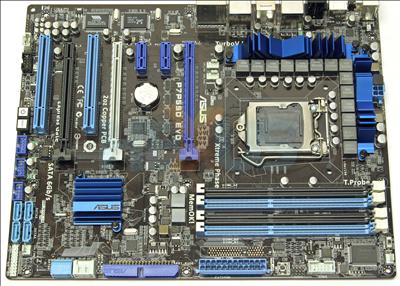The board
It's important to mention that the P7P55D is still a work in progress, and we may see a few different BIOS features on the retail version. The physical layout, however, should be final.The P7P55D EVO will be one of many ASUS P55 chipset-based boards, to be released once Intel lifts the embargo on LGA1156 chips. It can be thought of as a mid-to-high-end board, and we guesstimate that it'll cost around £125.
General layout is good, helped by LGA1156 chips not requiring two-bridge support, as per LGA1366. Remember, the PCIe connectivity is run off the CPU, so the X58's IOH (northbridge) is rendered redundant here, intimating that power-draw should be down a touch. ASUS wouldn't confirm if SLI will be supported, but we guess that different models in the range will accommodate either or both multi-GPU setups from ATI and NVIDIA.
Here's the socket that you'll become familiar with in coming months. The mounting holes are also different to LGA1366, so expect to see a bevy of supporting coolers - or brackets - released this autumn.
Lots of room around the socket should make for easy cooler mounting. We installed an LGA1156 chip - yes, we had one - with a rather large Zalman CNPS10X on top. Installation was a cinch, yet we reckon that it wouldn't hurt to include LGA775 mounting holes for users who already own those coolers.
A modicum of board real estate is also saved by having only four DIMM slots instead of the usual six. We like the 'Q-DIMM' clamp-less design on the left-hand side, as we first saw on the Rampage GENE, and it makes installing/removing RAM a simple affair even when a long-ish graphics card is in the primary PCIe slot.











